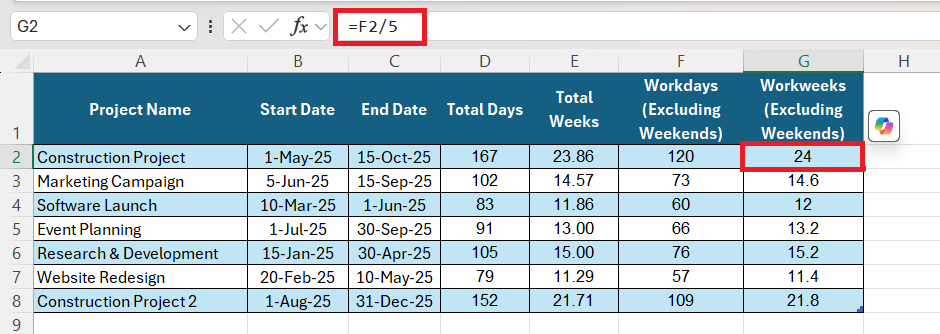When working with dates in Excel, I often need to determine the number of weeks between two dates. Whether I’m tracking project timelines, payroll cycles, or event planning, calculating weeks accurately helps me stay organized. In this Excel tutorial, I’ll walk you through various methods to determine how many weeks between two dates using Excel formulas.
Key Takeaways:
- Excel stores dates as serial numbers, allowing seamless date calculations.
- The DATEDIF function efficiently calculates weeks between dates, including partial weeks.
- Integer division using INT provides whole-week calculations for payroll and scheduling.
- The NETWORKDAYS function helps exclude weekends for precise workweek tracking.
- Combining date functions with conditional formulas enhances dynamic reporting.
Table of Contents
Unveiling the Mystery of Excel Date Calculations
Excel’s handling of dates and times often feels complex, but at its core, it follows a straightforward system: dates are stored as serial numbers, with one day equaling one increment starting from January 1, 1900. This system enables Excel to perform arithmetic operations on dates seamlessly.
Understanding how Excel processes dates allows me to manipulate and format them correctly for calculations like finding the number of weeks between two dates.
Methods to Calculate How Many Weeks Between Two Dates
Method 1: Using the DATEDIF Function
The DATEDIF function is an invaluable yet hidden gem in Excel that calculates the difference between two dates in various units, including weeks. This method is particularly useful for event planning, employee tenure tracking, and financial forecasting. Suppose a software development cycle starts on April 1 and ends on July 10. Using this method, I can quickly determine how many weeks the development phase spans, helping in milestone planning. Let’s check the steps:
STEP 1: Select your cells and enter the start date in A2 and the end date in B2.
STEP 2: Enter the Formula by clicking on the result cell and type:
=DATEDIF(A2, B2, “D”)/7
STEP 3: Press Enter, and if necessary, format the result as a number.
For the given example, from April 1 to July 10, the software development cycle lasts approximately 14.29 weeks. This method provides a precise breakdown of weeks, which is especially useful for project planning, ensuring accurate scheduling and resource allocation. The formula is flexible and can easily be adapted to calculate the difference in other units such as days, months, or years, depending on your needs.
Method 2: Using Integer Division for Whole Weeks
If I only need full weeks, this method helps round down to the nearest whole number. This is especially useful for determining full payroll weeks or eligibility periods for benefits. For example if an employee joins on March 1 and their probation period is 12 full weeks, I can use this method to calculate their probation end date accurately. Let’s see the steps:
STEP 1: Place the start date in column A and the end date in column B.
STEP 2: Click on the result cell and enter the formula:
=INT((B2 – A2)/7)
STEP 3: Press Enter to see the number of complete weeks between the dates.
The Integer Division method using the INT function is perfect for scenarios where only full weeks matter, such as payroll or benefits eligibility. In this example, an employee joining on March 1, 2025, would complete their 12-week probation period on May 24, 2025. The formula efficiently excludes partial weeks, ensuring that the calculation reflects only complete weeks, providing a precise and practical solution for determining full periods.
Method 3: Calculating Fractional Weeks
For a more precise calculation that includes both whole and partial weeks, I use this formula. This method is particularly useful for billing clients on a weekly basis when projects do not align perfectly with full weeks. If a consultant works on a project from February 10 to March 28 and charges on a weekly basis, this method helps calculate the total billable weeks, ensuring accurate invoicing. Let’s follow these steps:
STEP 1: Input the start date in A2 and the end date in B2.
STEP 2: Click on the result cell and type the formula:
=(B2 – A2)/7
STEP 3: Press Enter to get the number of total weeks, including any fractional part.
The Fractional Weeks method provides a precise calculation of both full and partial weeks, making it ideal for situations where billing needs to reflect exact time spent, such as consulting or project-based work. In this example, the consultant working from February 10 to March 28 would be billed for 6.57 weeks.
This approach ensures accurate invoicing, especially when projects don’t fit neatly into whole weeks. By including the decimal value, the method delivers a more nuanced view of the time period, which is essential for detailed and fair billing.
Real-World Scenarios: Putting Excel Date Magic to Work
Project Management: Tracking Time Spans Effortlessly
For project managers like me, tracking time spans accurately is critical. By calculating weeks between two dates, I can better allocate resources, set milestones, and ensure deadlines are met. Using the NETWORKDAYS function alongside these methods also helps exclude weekends for more precise tracking.
For example, if a construction project begins on May 1 and is expected to be completed by October 15, I can use these formulas to estimate the total weeks and determine the number of workweeks excluding weekends.
This table provides a clear structure for calculating various project timelines using Excel formulas. By utilizing the Total Days, Total Weeks, Workdays (Excluding Weekends), and Workweeks (Excluding Weekends) formulas, project managers can track project durations more effectively.
The formulas give a precise breakdown of time, helping in resource allocation and milestone management. The use of NETWORKDAYS ensures that weekends are excluded from work schedules, and the workweeks calculation divides the total workdays by 5, making it easy to assess the actual working time for a project.
Advanced Tips for Power Users
Combining Functions for Comprehensive Insights
I often merge date functions with conditional formulas like IF or TEXT to create dynamic reports that update automatically. This helps in lead time analysis, cycle duration tracking, and overdue task monitoring.
Let’s say I’m managing a sales team and tracking the progress of various deals. I want to calculate how many weeks have passed since the deal was initiated and also flag deals that require follow-up. Here’s how I can use combined date functions and conditional formulas to dynamically monitor sales progress.
By combining date functions with conditional formulas like IF, I can create a dynamic sales report that automatically tracks and flags overdue tasks. In this example, the Sales Deals database provides comprehensive insights into the number of days and weeks each deal has been open. Using conditional formatting, I can easily identify which deals need follow-up, ensuring that no task is overlooked. This approach can be expanded to monitor various project timelines, cycle durations, or even performance metrics, offering valuable insights into the status of different initiatives.
Formula Errors and Troubleshooting Tricks
When formulas return errors, I check for typos, incorrect cell references, or mismatched data types. Excel’s built-in error-checking tool helps identify issues, and breaking formulas into smaller segments simplifies debugging.
For instance, if a formula returns a #VALUE! error, it’s often due to text-formatted dates. Converting them to proper date format resolves the issue.
FAQ: Your Questions Answered
How to calculate how many weeks between two dates in Excel?
To calculate weeks between two dates in Excel, use the formula =(end_date – start_date)/7. If you want only whole weeks, use =INT((end_date – start_date)/7). Replace end_date and start_date with the appropriate cell references containing your dates.
What Exactly Is the DATEDIF Function in Excel?
The DATEDIF function in Excel is a “date difference” function that calculates the time difference between two dates, providing the result in years, months, or days. It’s especially useful for tracking periods such as age or tenure. Despite its power, it’s a hidden function not documented in Excel’s help resources.
How Do I Calculate Exact Duration Between Two Dates, Including Days?
To calculate the exact duration between two dates including days, use the DATEDIF function: =DATEDIF(start_date, end_date, “y”) & ” years, ” & DATEDIF(start_date, end_date, “ym”) & ” months, ” & DATEDIF(start_date, end_date, “md”) & ” days”, replacing start_date and end_date with your specific date cells.
How could you calculate the hours between two times after midnight in excel correctly?
To calculate the hours between two times after midnight in Excel correctly, subtract the start time from the end time and then multiply the result by 24. Use the formula =(end_time – start_time) * 24, ensuring both cells are formatted as ‘Time’. If the time spans over midnight, Excel automatically considers the date change.
How many weeks in a year?
There are typically 52 weeks in a year. However, because a year is actually slightly longer than 52 weeks – 52 weeks and 1 day, or 52 weeks and 2 days in leap years – some years have 53 weeks. The 53rd week is included in years where January 1st or December 31st falls on a weekday.
John Michaloudis is a former accountant and finance analyst at General Electric, a Microsoft MVP since 2020, an Amazon #1 bestselling author of 4 Microsoft Excel books and teacher of Microsoft Excel & Office over at his flagship MyExcelOnline Academy Online Course.


















